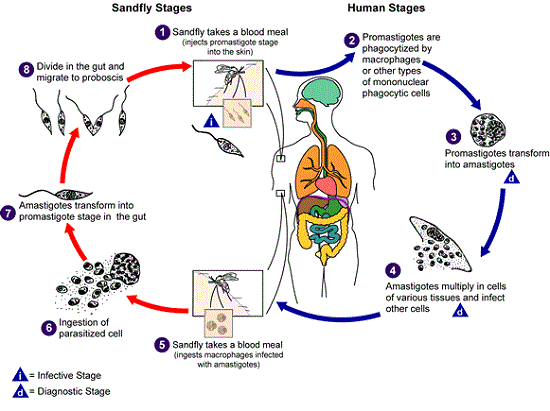Leishmania donovani - Life Cycle, Epidemiology, Reservoir, Transmission, Treatment, Prevention, Control
Life Cycle of Leishmania donovani
The life cycle of Leishmania donovani is completed in two different hosts:
Man or other mammals- the amastigote form
Sandfly of genus Phlebotomus and Lutzomyia – the promastigote form
These mammals include dogs, rodents, foxes, etc.
Leishmania donovani is transmitted to man and other vertebrates by the bite of a blood-sucking female sandfly
During the blood meal, the promastigotes are transmitted from the saliva of the vector to the host’s skin
the promastigotes are then immediately phagocytosed by the host macrophages where they transform into amastigotes
the newly formed Leishmania donovani amastigotes undergo binary fission to produce a large number of amastigotes which continue to divide inside the enlarged macrophages
the infected macrophages rupture to release a large number of amastigotes (around 200 in number) into the host body circulation
the parasites then invade the monocytes of the blood, macrophages of the spleen, liver, bone marrow, lymph nodes as well as other tissues of the reticuloendothelial cells
if the infected mammal host (including man) is bitten by a female sand-fly during a blood meal, the free amastigotes are also taken up with the host blood
in the midgut of the sand-fly, within 72 hours, the Leishmania donovani amastigotes are transformed into promastigotes
the morphological transformation takes place through a series of flagellated intermediate promastigote forms to flagellated promastigotes
the promastigotes undergo binary fission, produce a large number of parasites, and completely fill the lumen of the gut
after 6-9 days, the promastigotes travel to the sandfly's pharynx and buccal cavity from the mid-gut
bite from the infected sand-fly to mammals (including humans) during its blood meal transmits the infection and the life cycle of Leishmania donovani is continued

Figure: L. donovani life cycle (Source: CDC)
Epidemiology of Leishmania donovani
Epidemiologically, Leishmania donovani is found in 88 countries (16 industrialized and 72 developing countries)
the continents Australia and Antarctica are free of leishmaniasis while Asia, Africa, South America, North America, and Europe have recorded cases of leishmaniasis to varying degrees
Reservoir, Source of Leishmania donovani
The reservoir of Leishmania donovani depends upon the area of the globe where the infection is occurring.
In India, only human-sandfly transmission occurs and humans are the only reservoir
rodents are reservoirs of Leishmania donovani in Africa
foxes are reservoirs of Leishmania donovani in Brazil and Central Asia
canines reservoirs of Leishmania donovani in China and the Mediterranean
Transmission of Leishmania donovani
occurs mainly by the bite of vector i.e. sand-fly (Phlebotomus argentipes)
less frequently, Leishmania donovani transmission occurs via
blood transfusion
congenital infection
unprotected sexual intercourse
accidental infection in a laboratory setting
Treatment of Leishmania donovani
The treatment of leishmaniasis, caused by Leishmania donovani, includes
specific therapy supplemented with the treatment of secondary infections
high-calorie diet
blood transfusion in cases of severe anemia
Drugs used include:
Pentavalent antimonials
megalumine antimonate
sodium stibugluconate solution
Pentamidine
pentamidine isethionate
pentamidine dimethane
Amphotericin B
Miltefosine
Interferon
Prevention, Control of Leishmania donovani
The prevention, control of Leishmania donovani can be done as:
reduction of sand-fly population by using insecticides
evade contact with potential animal vectors such as dogs, foxes, and rodents
use of bed nets, window nets, or insect repellents